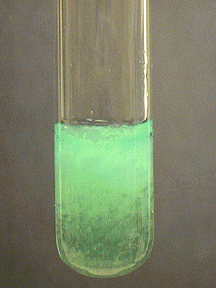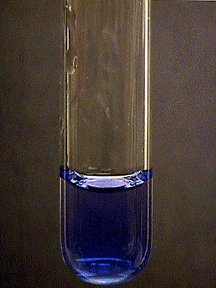Characteristic Reactions of Nickel Ions (Ni²⁺)
- Page ID
- 97275
- Most common oxidation state: +2
- M.P. 1453º
- B.P. 2732º
- Density 9.91 g/cm3
- Characteristics: Nickel is a silvery-gray metal. Not oxidized by air under ordinary conditions. Easily dissolved in dilute nitric acid.
Characteristic Reactions of Ni²⁺
Nickel(II) ion forms a large variety of complex ions, such as the green hydrated ion, \(\ce{[Ni(H2O)6]^{2+}}\).
Aqueous Ammonia
Aqueous ammonia precipitates green gelatinous Ni(OH)2:
\[\ce{Ni^{2+}(aq) + 2NH3(aq) + 2H2O(l) <=> Ni(OH)2(s) + 2NH4^{+}(aq)} \nonumber \] 
The nickel(II) hydroxide precipitate dissolves in excess ammonia to form a blue complex ion:
\[\ce{Ni(OH)2(s) + 6NH3(aq) <=> [Ni(NH3)6]^{2+}(aq) + 2OH^{-}(aq) } \nonumber \] 
Sodium Hydroxide
Sodium hydroxide also precipitates nickel(II) hydroxide:
\[\ce{Ni^{2+}(aq) + 2OH^{-}(aq) <=> Ni(OH)2(s)} \nonumber \] 
Nickel(II) hydroxide does not dissolve in excess \(\ce{NaOH}\).
Dimethylglyoxime
Addition of an alcoholic solution of dimethylglyoxime to an ammoniacal solution of Ni(II) gives a rose-red precipitate, abbreviated \(\ce{Ni(dmg)2}\):
\[\ce{[Ni(NH3)6]^{2+}(aq) + 2(CH3CNOH)2(alc) <=> Ni[ONC(CH3)C(CH3)NOH]2(s) + 2NH4^{+}(aq) + 4NH3(aq)} \nonumber \] 
Sulfide
Black \(\ce{NiS}\) is precipitated by basic solutions containing sulfide ion:
\[\ce{Ni^{2+}(aq) + S2^{-}(aq) <=> NiS(s)} \nonumber \] 
Nickel(II) sulfide is not precipitated by adding \(\ce{H2S}\) in an acidic solution. In spite of this, \(\ce{NiS}\) is only slightly soluble in \(\ce{HCl}\) and has to be dissolved in hot nitric acid or aqua regia, because \(\ce{NiS}\) changes to a different crystalline form with different properties.
No Reaction
\(\ce{Cl^{-}}\), \(\ce{SO4^{2-}}\)


